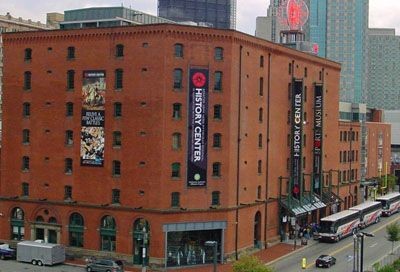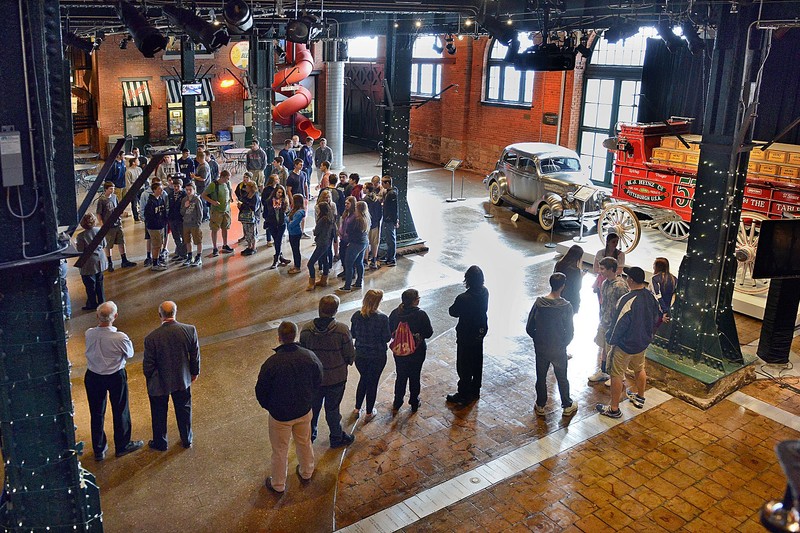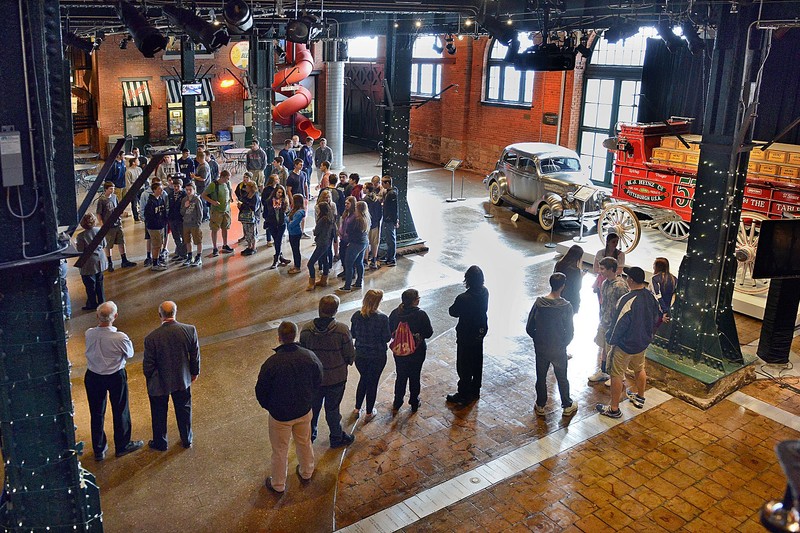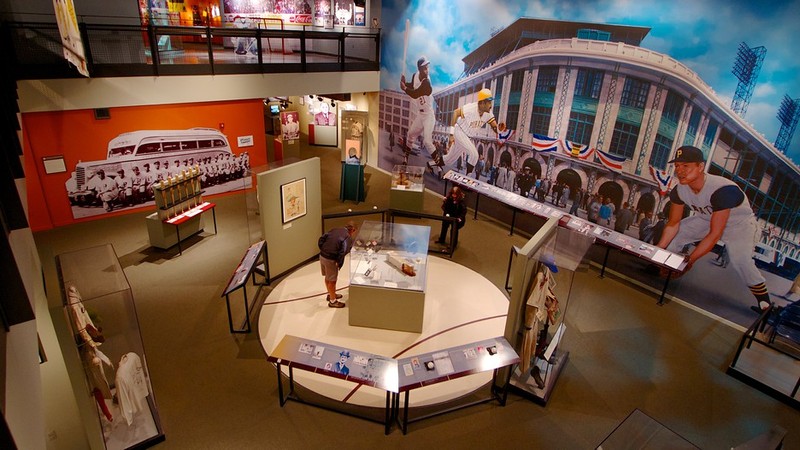Heinz History Center
Introduction
Text-to-speech Audio
Located along Smallman Street in the Strip District of Pittsburgh, the Heinz History Center includes 275,000 square feet of exhibits and archives devoted to the study of western Pennsylvania’s history. The center opened for visitors in 1996 in the former Chautauqua Lake Ice Company building after ten years of fundraising and renovations and added a Smithsonian wing eight years later after becoming a Smithsonian Institution affiliate in 2000. Operated by the Historical Society of Western Pennsylvania, the center is named for the noted politician and philanthropist Senator John Heinz. Since its inception, the Heinz History Center has become Pennsylvania’s largest history museum, with over 40,000 artifacts throughout six floors of exhibition space and satellite museums at the Fort Pitt site and the Meadowcroft Rockshelter and Historic Village. The Heinz History Center is open from 10 AM to 5 PM daily.
Images
Exterior of the Heinz History Center

Ground floor exhibit space within the center.

As one would expect, sports history has its own exhibit in a history center located in Pittsburgh.

As expected, sports history plays a large role in a history center located in Pittsburgh.

Backstory and Context
Text-to-speech Audio
The push to create a museum that could serve as the centerpiece of Pittsburgh and western Pennsylvania’s historical community originated with a conference on November 16, 1985 hosted by the Committee of Pittsburgh Archaeology and History titled “Salvaging Pittsburgh’s Past: A City History Museum.” The conference highlighted the urgency of establishing a more formal infrastructure for preserving the region’s past, particularly artifacts from its rapidly vanishing industrial heritage. The Historical Society of Western Pennsylvania took up the mantle of this project the following year under the leadership of society president William C. King, who hired John Herbst as executive director (expressly for the purposes of creating an industrial museum) and initiated a $21,000 study to determine the best means of moving forward. The study considered twenty buildings in the Pittsburgh area as potential locations for the new museum, including the Greyhound Terminal on Liberty Avenue, the Armstrong Cork building in the Strip District, and the Lawrence Paint Company building on West Carson street, before settling on the former Chautauqua Ice Company warehouse on Smallman Street in 1989.
The warehouse, constructed in the 1880s, was owned at the time by BT Corporation, a private firm operated by descendants of the original owners, and occupied by the Adelman Lumber Company. Together with two adjacent four-story buildings, the seven-story former Chautauqua complex the historical society sought to purchase occupied the entire block on Smallman between Twelfth and Thirteenth Streets. Through a grant from Allegheny County, the society was able to purchase the buildings on Smallman for $3.1 million and begin moving forward with its plans to renovate and combine the buildings into a single complex for a projected cost of $11-20 million. With Pittsburgh native David McCullough as honorary head of its fundraising campaign, the historical society was able to pull together over $30 million in donations and grants from the state of Pennsylvania and National Endowment for the Humanities. These funds paid for the renovations that architects Bohlin Cywinski Jackson and Notter Finegold & Alexander Incorporated oversaw beginning in 1992. The historical society held its groundbreaking ceremony on March 9, 1994 and announced two months later that the museum would be named in honor of Senator John Heinz (who had died unexpectedly three years earlier). The Senator John Heinz History Center opened for visitors on April 29, 1996.
The history center has expanded its operations considerably since its opening in 1996. In 1999, the Historical Society of Western Pennsylvania announced its intention as part of a five-year plan to absorb the Meadowcroft Museum of Rural Life in Avella, Pennsylvania fully into the Heinz History Center system, an intention that culminated with the opening of the Meadowcroft Rockshelter and Historic Village Site. The following year the Heinz History Center officially became an affiliate of the Smithsonian Institution. This agreement granted the center access to Smithsonian artifacts related to the history of the region and resulted in the construction of a $27 million five-story Smithsonian wing in 2004 that includes a two-floor Western Pennsylvania Sports Museum. Five years after the Smithsonian expansion, the Heinz History Center system grew once more with the acquisition of the Fort Pitt Museum in Point State Park, a response to budget shortfalls that threatened the Fort Pitt Museum’s closure. In conjunction with its operation of the Detre Library & Archives, the Heinz History Center’s expansion efforts have ensured its status as a premier museum in Pennsylvania and undisputed centerpiece of the regional historical community.
Over the course of its operation, exhibits in the Heinz History Center have included “We Can Do It! WWII,” an examination of Pittsburgh during the Second World War, the city’s influence on the war, and the war’s effect on the city; “Mister Roger’s Neighborhood” in the Special Collections Gallery, displaying artifacts from the show and set; the Heinz exhibition, illustrating the 145 year history of the company; “Pittsburgh: A Tradition for Innovation”; “From Slavery to Freedom”; “Clash of Empires: The British, French, and Indian War 1754-1763”; “Close Up: Photographs from the Pittsburgh Post-Gazette, 2014”; and “Glass: Shattering Notions,” which looks at glass making and its history in the Steel City. The center’s major collections include H.J. Heinz, Westinghouse, Alcoa, and Gulf, but the history center also displays items from everyday life depicting the history and culture of Pittsburgh, such as letters, photos, paintings, uniforms, and records. The history center’s programs include the African American Program, the Italian American Program, the Rauh Jewish Achieves, and the Westinghouse Collection.
Such exhibitions have offered visitors to the Heinz History Center an unparalleled opportunity to understand the deep and complex histories of race, gender, ethnicity, disability, and class in Pittsburgh and the surrounding region. The opening of the center in 1996 represents a major turning point in the story of both the regional historical community and the Historical Society of Western Pennsylvania itself. What began in 1879 as an organization known as the Old Residents of Pittsburgh and Western Pennsylvania that limited its membership to men who had lived in the region for at least fifty years has become the foremost purveyor of a more equitable, inclusive, and authentic view of the past. As the Historical Society of Western Pennsylvania’s operations continue to expand in the coming years, the Heinz History Center will no doubt only further augment its reputation for scholarly excellence.
Sources
Barnes, Tom. "County to Aid History Center." Pittsburgh Post-Gazette December 17th 1991. 1.
Bauman, John F.. "Preserving Pittsburgh's Industrial History." Pittsburgh Post-Gazette February 17th 1990. 10.
Boyer, Lauren. "Heinz History Center to Operate Fort Pitt Museum." Pittsburgh Post-Gazette June 18th 2009. B1.
Chute, Eleanor. "2 Firms Hired to Design History Center in Strip." Pittsburgh Press February 14th 1992. B1.
"Group Studying Pittsburgh History Museum." Pittsburgh Press August 23rd 1986. C1.
Lowry, Patricia. "Heinz, Smithsonian Museums Affiliate." Pittsburgh Post-Gazette July 25th 2000. D1.
Lowry, Patricia. "Reviving History." Pittsburgh Post-Gazette February 28th 1999. A1.
Lowry, Patricia. "'Took Me Back': Visitors Wax Nostalgic at the Opening of the Regional History Center." Pittsburgh Post-Gazette April 29th 1996. D1.
Miller, Donald. "History Center Honors Heinz." Pittsburgh Post-Gazette June 16th 1994. C1.
Miller, Donald. "History Takes Center Stage." Pittsburgh Post-Gazette November 28th 1989. 15.
"New Man on History." Pittsburgh Post-Gazette June 5th 1986. 19.
"Pittsburgh Cultural Sites Getting Makeovers." Times-Leader (Wilkes-Barre, Pennsylvania) June 20th 2004. 5B.
Twedt, Steve. "History Center Will Be 1st of Kind." Pittsburgh Post-Gazette February 28th 1994. B4.
